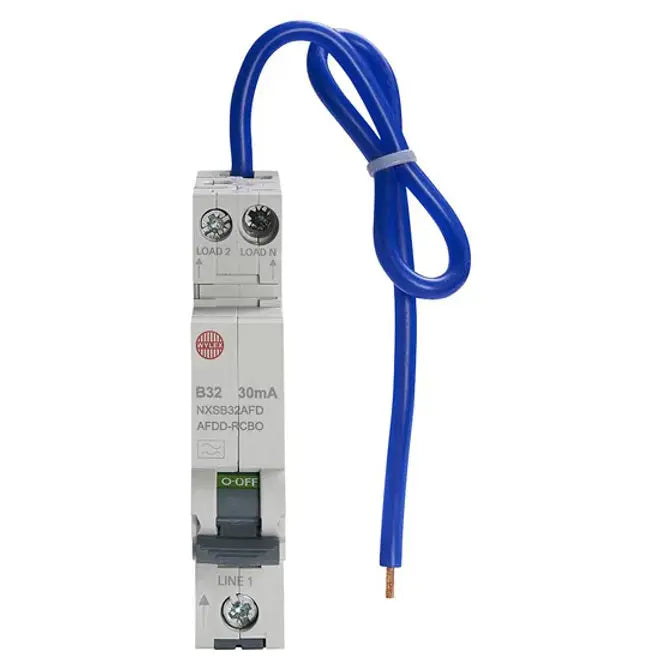Payment & Security
Your payment information is processed securely. We do not store credit card details nor have access to your credit card information.
Description
Understanding the Wylex NXSB32AFD 32A B Type 1P+N RCBO / AFDD
AFDD's detect electrical arcing faults that MCBs, RCDs and RCBOs cannot detect, providing an extra layer of circuit protection for many applications.
Arc fault detection devices offer extremely effective protection against fires that are started by electrical faults. Typical causes include loose connections, damaged cables, crushed cables or where aged insulation allows current to leak between conductors.
- Height: 90mm
- Width: 18mm
- Depth: 77mm
- Standards: BS EN 62606 & IEC 61009-1
- Single Module
- Easy installation
Avaible in Multiple Amperages B06-B40
Key Features of the Wylex NXSB32AFD
The Wylex NXSB32AFD 32A B Type 1P+N RCBO integrates advanced technology with reliable performance, making it an essential device for electrical safety. It combines both Residual Current Breaker with Overcurrent Protection (RCBO) and Arc Fault Detection Device (AFDD) functionalities. This means that it not only safeguards against overloads and short circuits, but also detects arc faults that can lead to fire hazards. Because of these features, it ensures comprehensive protection for modern electrical systems.
Benefits of Using the Wylex NXSB32AFD
By using the Wylex NXSB32AFD, users can significantly enhance their electrical safety system. It provides peace of mind, knowing that protection is in place against both overcurrent issues and potential electrical fires caused by arc faults. This dual protection is crucial, especially in residential and commercial areas where the risk of electrical malfunctions is prevalent. So, this device not only complies with safety regulations but also promotes a safer environment for everyone.
Installation and Compatibility of the Wylex NXSB32AFD
The Wylex NXSB32AFD is designed for easy installation in most standard electrical circuits. It is compatible with various Wylex consumer units, simplifying upgrades to current electrical installations. However, it is always recommended to have a qualified electrician perform the installation to ensure compliance with local regulations and standards. This ensures that the device operates effectively and safely within your electrical system.
Frequently Asked Questions
Find answers to common questions about our products and services
We offer standard delivery (2-5 working days) and express delivery (1-2 working days). Free standard delivery on orders over £85. All orders are tracked, and you'll receive updates via email.
We accept returns within 30 days of delivery. Items must be unused and in original packaging. Simply contact our customer service team to initiate a return. Refunds are processed within 2-5 working days once items are received
Feel free to drop us a message using the chat button in the bottom right, and one of our team members will get back to you as soon as they can. Alternatively, you can give us a call on 01924 4222999 (Ext 2) or send us an email at acaselec@gmail.com
Yes, all our products are fully certified and sourced from trusted UK suppliers.
We only stock genuine items from reputable brands, ensuring every product meets UK safety and quality standards. All products are held in our UK warehouse.
Our customer support team is available Monday-Friday, 9am-5pm. You can reach us via email, phone, or live chat. We aim to respond to all enquiries within 24 hours.
Yes, we offer competitive pricing for trade customers and bulk orders. Contact our sales team for a custom quote on larger quantities or ongoing supply arrangements.

